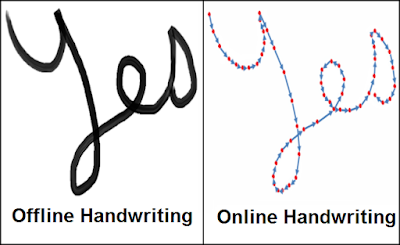Offline handwritten signature verification using local and global features
http://repository.vnu.edu.vn/handle/VNU_123/11767
This paper presents a new approach to address the problem of
offline handwritten signature verification. In contrast to many existing
systems, we are interested in making soft decision rather than a purely binary
classification for the signatures under verification.
To accomplish this goal, we incorporate both types of
features: finer intensity-based features and global geometry-based features.
Particularly, the finer features are computed for every sample point of a
signature using histogram of intensities, and the geometry-based features are
extracted using an adaptation of the shape context descriptor.
One of the advantages of our approach is that the extracted
features are very robust to noise, rotation and scaling change without heavily
relying on any complicated pre-processing steps.
The extracted features are used to compute the similarity
score, followed by a score calibration process to estimate the corresponding
confidence score (i.e., using log-likelihood-ratio).
To validate our work, we submitted our system to the
signature verification competition (SignComp2011) and achieved quite good
results.
Title: Offline
handwritten signature verification using local and global features
Authors: The-Anh
Pham , Hong-Ha Le, Nang-Toan Do
Keywords: Signature
verification Questioned document examination Handwriting recognition Shape
context descriptor Likelihood analysis
Issue Date: 2014
Publisher: Annals
of Mathematics and Artificial Intelligence
Abstract: This
paper presents a new approach to address the problem of offline handwritten
signature verification. In contrast to many existing systems, we are interested
in making soft decision rather than a purely binary classification for the
signatures under verification. To accomplish this goal, we incorporate both
types of features: finer intensity-based features and global geometry-based
features. Particularly, the finer features are computed for every sample point
of a signature using histogram of intensities, and the geometry-based features
are extracted using an adaptation of the shape context descriptor. One of the
advantages of our approach is that the extracted features are very robust to
noise, rotation and scaling change without heavily relying on any complicated
pre-processing steps. The extracted features are used to compute the similarity
score, followed by a score calibration process to estimate the corresponding
confidence score (i.e., using log-likelihood-ratio). To validate our work, we
submitted our system to the signature verification competition (SignComp2011)
and achieved quite good results.
URI: http://repository.vnu.edu.vn/handle/VNU_123/11767
Appears in Collections: ITI
- Papers



Nhận xét
Đăng nhận xét